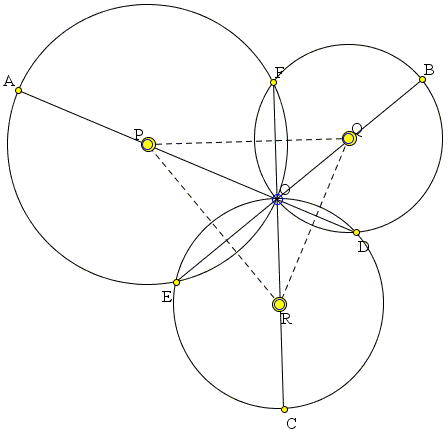Simultaneous Diameters in Concurrent Circles
What is this about?
A Mathematical Droodle
| What if applet does not run? |
|Activities| |Contact| |Front page| |Contents| |Geometry|
Copyright © 1996-2018 Alexander Bogomolny
The applet attempts to suggest the following problem [Geometry, p. 258]:
Three circles, say, (P), (Q), (R), concur at point O, and meet at three other points D, E, and F, as illustrated in the applet. The following sets of points are collinear: A, O, D; B, O, E; C, O, F. OA is a diameter of (P); OB is a diameter of (Q). Prove that OC is a diameter of (R).
| What if applet does not run? |
Proof 1
Invert the diagram in a circle with center O. Circles (P), (Q), (R) map onto straight lines that form a triangle with vertices D', E', F' which are respective images of D, E, F. Lines AD, BE, CF that pass through the center O of inversion map onto themselves and thus serve cevians in ΔD'E'F' that concur at O.
Every diameter in a circle is perpendicular to a circle, i.e., to the tangents at its endpoints. Thus, e.g.,
Proof 2
Let A' lie on (P) in an arc EF that does not contain O. Define B' as the second intersection of A'F with (Q), and C' as the second intersection of A'E with (R). We know that B'C' pass through D. Furthermore, position of A' does not affect the angles in ΔA'B'C', so that all those triangles are similar. One of these triangles is the largest. This is the triangle for which OA', OB', OC' are the diameters of (P), (Q), and (R), respectively. In fact, if one of them is a diameter, so are the other two.
We are in fact given that, for A' = A, B' = B. We need to show that then
Since OA is a diameter of (P), ∠AEO = 90°. Since OB is a diameter of (Q), ∠BDO = 90°, implying that in ΔABC', AD and BE are altitudes, O the orthocenter, and C'O is the thrid altitude. But, since OA is a diameter of (P),
Proof 3
This proof has been devised by Patrick Honner and relates to the following diagram:

I placed the proof on a separarte page.
Proof 4
The problem admits a generalization: instead of the common chords, we may consider the radical axes of two circles. Such a generalization is indeed valid and is treated on a separate page. The concurrency of the circles appears to be a red herring.
References
- D. A. Brannan, M. F. Esplen, J. J. Gray, Geometry, Cambridge University Press, 2002
Inversion - Introduction
- Angle Preservation Property
- Apollonian Circles Theorem
- Archimedes' Twin Circles and a Brother
- Bisectal Circle
- Chain of Inscribed Circles
- Circle Inscribed in a Circular Segment
- Circle Inversion: Reflection in a Circle
- Circle Inversion Tool
- Feuerbach's Theorem: a Proof
- Four Touching Circles
- Hart's Inversor
- Inversion in the Incircle
- Inversion with a Negative Power
- Miquel's Theorem for Circles
- Peaucellier Linkage
- Polar Circle
- Poles and Polars
- Ptolemy by Inversion
- Radical Axis of Circles Inscribed in a Circular Segment
- Steiner's porism
- Stereographic Projection and Inversion
- Tangent Circles and an Isosceles Triangle
- Tangent Circles and an Isosceles Triangle II
- Three Tangents, Three Secants
- Viviani by Inversion
- Simultaneous Diameters in Concurrent Circles
- An Euclidean Construction with Inversion
- Construction and Properties of Mixtilinear Incircles
- Two Quadruplets of Concyclic Points
- Seven and the Eighth Circle Theorem
- Invert Two Circles Into Equal Ones
|Activities| |Contact| |Front page| |Contents| |Geometry|
Copyright © 1996-2018 Alexander Bogomolny
71752858
